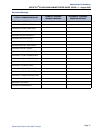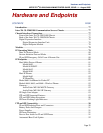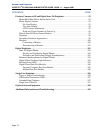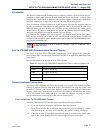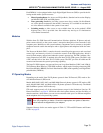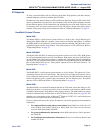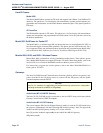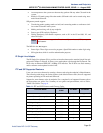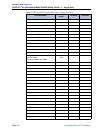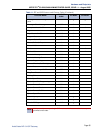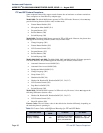
Hardware and Endpoints
INTER-TEL
®
CS-5200/5400 ADMINISTRATOR GUIDE, ISSUE 1.1 – August 2005
Digital Endpoint Module
Page 79
Each DEM-16 is also equipped with a single Digital Signal Processor (DSP) to provide the fol-
lowing module and/or system resources:
• Shared speakerphones for Axxess and Eclipse Basic, Standard and Associate Display,
and Models 8500, 8520, and 8560 phones.
• Tone generating circuit for providing system tones (busy, reorder, Do-Not-Disturb,
etc.) to the phones connected to the module, if necessary. It is available in case there are
no voice channels available in the system to issue tones.
• Switching matrix to allow access to any available time slot on the module’s PCM
highway (bus). This is provided since the module may need up to 32 simultaneous
voice channel connections.
Modules
With the Inter-Tel 5000 Network Communications Solutions platform, IP phones and end-
points connect directly to the system owner’s enterprise through local area network (LAN)
computer ports. Modules are the system hardware components used to connect to the public
telephone network outside the enterprise and to digital phones and endpoints inside the enter-
prise.
The Processor Module (PM-1) contains the main controlling microprocessor and associated
control logic and memory circuits. It is under the control of the IPR Application, which is
stored in flash memory and activated when the system is powered up. The PM-1 without a Pro-
cessor Expansion Card (PEC-1) attached drives the Inter-Tel CS-5200 system. The PM-1 with
a PEC attached drives the Inter-Tel CS-5400 system. The PEC provides 82 additional IP
resources and increases the system’s processing capability.
The Inter-Tel 5000 supports two-port and four-port Loop Start Modules (LSM-2 and LSM-4),
T1/E1/Primary Rate Interface (T1/E1/PRI) modules, which require licensing when using PRI,
Basic Rate Modules (BRM-S) for Basic Rate Interface (BRI) trunk capability, and Digital End-
point Modules (DEM-16).
IP Operating Modes
Depending on the model, Inter-Tel IP phones operate in Inter-Tel Protocol (ITP) mode or Ses-
sion Initiation Protocol (SIP) mode.
Models 8600, 8620, 8622, 8662, and 8690 Multi-Protocol phones operate in ITP mode or SIP
mode. Models 8664, 8665, and 8668 wireless IP phones operate in ITP mode only. The Model
8601 SoftPhone operates in SIP mode only.
ITP mode supports nearly all of the system features except for the limitations listed on “IP
Phone Limitations” on page 91. SIP mode offers basic phone features and the flexibility of
shared extensions, which means you can use one extension with up to five different endpoints
on the telephone and voice processing systems.
Supported features for the two modes appear in Table 11, "ITP and SIP Features and Feature
Codes" on page 83.
NOTE
An endpoint may have certain hardware and software restrictions that prevent it
from fully supporting a feature. Consult the appropriate user guide to determine
which features are supported for your endpoint.



